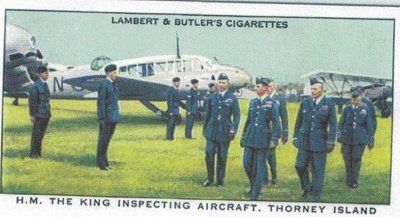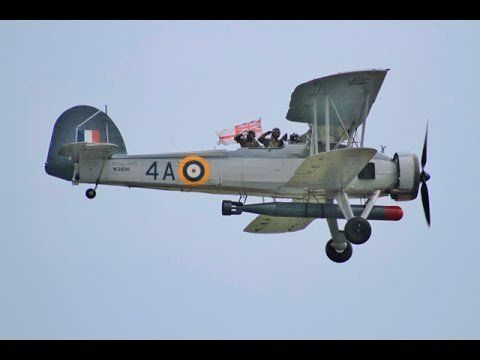The Story of RAF Thorney Island
It Starts with a Tradegy
In September 1933 a Hawker Fury Mk1 aircraft crashed in a field just north of Thorney Church resulting in the death of the airman. A commemorative plaque has been erected to the unknown airman and marks the spot where his craft crashed.
Accident Investigators came to the site to examine the wreckage and they reported the potential of the area to the Air Ministry who observed the unique suitability of the adjoining land as an airfield and their plans completely altered the island. Residents began to be evacuated and by the Summer of 1935 building had begun on what would later be known as RAF Thorney Island. See the press report on our Reference page.
RAF Thorney Island becomes Operational
In 1938 the RAF base was opened by George VI (commemorated by a cigarette card above) and became home to Swordfish and Vildebeest of the Fleet Air Arm (while their carriers were in Portsmouth?) and many other craft throughout World War II.
The story of the 1939-45 air war from Britain’s defence to the liberation of Europe is told on the Squadron Boards in St Nicholas Church. At that time the base consisted of three concrete runways equipped with aircraft hangars.
In the Battle of Britain it was used by fighter aircraft of 236 Squadron of 11 Group, being attacked by Stuka dive bombers on the 18th August 1940.
The Early Aircraft at RAF Thorney Island
The Fairey Swordfish
The Fairey Swordfish is the iconic aircraft of Royal Navy air power. A 3-man crew would pilot this biplane from their air-craft carriers (ships with flat decks for take-off and landing) to bomb or torpedo hostile ships. Brave men flying these slow craft are credited with crippling the Bismark and destroying the Italian fleet. Key actions that won the war at sea to ensure Britain's survival as a free nation.
The Vickers Vildebeest
The Vickers Vildebeest is of the same era as the Swordfish, a smaller craft with perhaps a lower range. These were some of the first aircraft stationed at RAF Thorney Island, perhaps as trainers on which to practice the skills of deck landing, short take-off, navigating to target and dropping bombs or torpedoes. Such biplanes offered short take-off & landing with an air-frame of fabric and wood that could be maintained at sea.
The Bristol Beaufort
Another aircraft stationed in the early years of RAF Thorney Island was the Bristol Beaufort. The principal reconnaissance aircraft of late 1930s Coastal Command, the Beaufort would sweep the Western Approaches for raiders and deter them with bombs and strafing runs. Keeping the seaways open for Atlantic convoys and coastal shipping was a crucial strategic necessity that kept Britain fed and fueled and able to fight.
Through the 1940s
The airfield opened as an RAF Coastal Command unit with aircraft like the Beaufort and Wellington suited to coastal reconnaissance and shipping protection duties. The Swordfish and Vildebeest biplanes, though of a past era, were significant in the carrier engagements in the Atlantic (sinking the Bismark) and the Mediterranean (the Torranto attack). Their presence on Thorney Island are suspected to be during Carrier refits in Portsmouth Harbour and occur through the air war.
Thorney Island's location on the South Coast soon made it popular for a wide range of other operational roles including air defense, bombing, Army cooperation and Naval development activities. In common with many other RAF stations during World War II, many active squadrons were also temporarily detached there as hostilities progressed. Going to and fro, the Anson would offer personnel transfer for flight crew and essential spares.
Into 1944 sees the range of attack aircraft being stationed on Thorney. The iconic Mosquito of 633 Squadron fame flew from Thorney on precision bombing and path-finding duties as the suppression of hostile movement in Northern France prepared the ground for the D-Day on 6th June 1944. The Typhoon was the workhorse of this campaign, strafing any thing that moved and rocket attack of trains, lorry convoys and command centres.
The Post War Era - 1945 to 1976
In 1948 three squadrons operating Meteor fighter aircraft moved in, making way for No 2 Air Navigation School in 1950. This unit trained navigators to support the many expanding roles of a modern air force from precision navigation to weapon management and delivery. As part of the post war rationalisation process, the station was used for Survival and Rescue training and hosted a Torpedo Training Unit.
In 1962 the Air Navigation School moved out to make way for No 242 Operation Conversion Unit which trained aircrew in the tactical and long range transport role, initially with Hastings and Beverley aircraft, and finally with the C-130 Hercules. The flight path for the main runway took aircraft low over Southbourne – a red light shone at the top of St John’s spire! – and residents would remember the sound of these large craft, lumbering overhead on their final approach.
It is likely the air-bases east of Suez would have been supported by spares and equipment flown out from Thorney Island. The withdrawal from Britain’s colonial air bases may have come back using the same routes.
A familiar sight and sound from 1955 to 1973 was a 22 Sq. flight operating the Whirlwind helicopters on Search and Rescue duties. Again, the St Nicholas Squadron Boards tell the story of this transition in role from the 1950’s to the 1970’s
The RAF station finally closed in 1975 and is remembered in a commemorative window placed where the North door used to be. The RAF had operated St Nicholas as the base Church and a list of RAF chaplains hangs by the South door. Reverting to the Chichester Diocese, Thorney Island parish merged with Southbourne in 1980.











